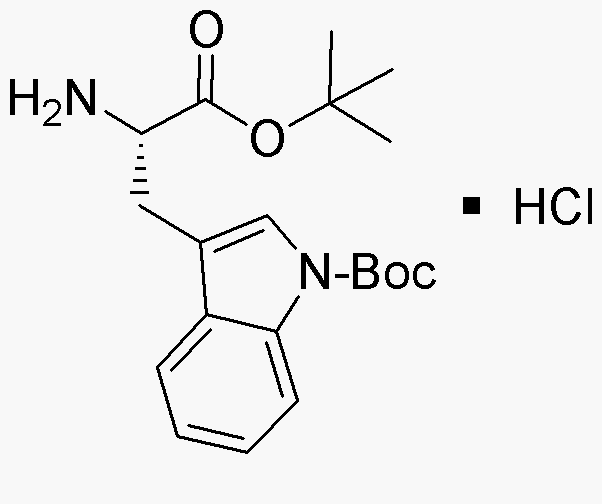Nin-Boc-L-tryptophan tert-butyl ester hydrochloride is widely utilized in research focused on:
- Peptide Synthesis: This compound serves as a crucial building block in the synthesis of peptides, particularly those involving tryptophan. Its protective Boc group allows for selective reactions, making it ideal for complex peptide assembly.
- Drug Development: In pharmaceutical research, it is used to create novel compounds that can modulate serotonin pathways, which are vital for treating mood disorders and other neurological conditions.
- Biochemical Studies: Researchers employ this chemical in studies exploring the role of tryptophan in protein structure and function, aiding in the understanding of enzyme mechanisms and metabolic pathways.
- Cosmetic Formulations: The compound is also explored in the cosmetic industry for its potential antioxidant properties, contributing to formulations aimed at improving skin health and appearance.
- Food Industry Applications: Its derivatives are investigated for use in food additives and flavor enhancers, leveraging the natural properties of tryptophan to enhance taste and nutritional value.
General Information
Properties
Safety and Regulations
Applications
Nin-Boc-L-tryptophan tert-butyl ester hydrochloride is widely utilized in research focused on:
- Peptide Synthesis: This compound serves as a crucial building block in the synthesis of peptides, particularly those involving tryptophan. Its protective Boc group allows for selective reactions, making it ideal for complex peptide assembly.
- Drug Development: In pharmaceutical research, it is used to create novel compounds that can modulate serotonin pathways, which are vital for treating mood disorders and other neurological conditions.
- Biochemical Studies: Researchers employ this chemical in studies exploring the role of tryptophan in protein structure and function, aiding in the understanding of enzyme mechanisms and metabolic pathways.
- Cosmetic Formulations: The compound is also explored in the cosmetic industry for its potential antioxidant properties, contributing to formulations aimed at improving skin health and appearance.
- Food Industry Applications: Its derivatives are investigated for use in food additives and flavor enhancers, leveraging the natural properties of tryptophan to enhance taste and nutritional value.
Documents
Safety Data Sheets (SDS)
The SDS provides comprehensive safety information on handling, storage, and disposal of the product.
Product Specification (PS)
The PS provides a comprehensive breakdown of the product’s properties, including chemical composition, physical state, purity, and storage requirements. It also details acceptable quality ranges and the product's intended applications.
Certificates of Analysis (COA)
Search for Certificates of Analysis (COA) by entering the products Lot Number. Lot and Batch Numbers can be found on a product’s label following the words ‘Lot’ or ‘Batch’.
Número de catálogo
Número de lote/lote
Certificates Of Origin (COO)
This COO confirms the country where the product was manufactured, and also details the materials and components used in it and whether it is derived from natural, synthetic, or other specific sources. This certificate may be required for customs, trade, and regulatory compliance.
Número de catálogo
Número de lote/lote
Safety Data Sheets (SDS)
The SDS provides comprehensive safety information on handling, storage, and disposal of the product.
DownloadProduct Specification (PS)
The PS provides a comprehensive breakdown of the product’s properties, including chemical composition, physical state, purity, and storage requirements. It also details acceptable quality ranges and the product's intended applications.
DownloadCertificates of Analysis (COA)
Search for Certificates of Analysis (COA) by entering the products Lot Number. Lot and Batch Numbers can be found on a product’s label following the words ‘Lot’ or ‘Batch’.
Número de catálogo
Número de lote/lote
Certificates Of Origin (COO)
This COO confirms the country where the product was manufactured, and also details the materials and components used in it and whether it is derived from natural, synthetic, or other specific sources. This certificate may be required for customs, trade, and regulatory compliance.


